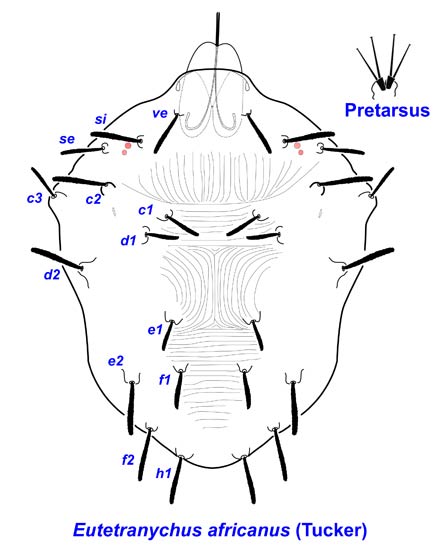Eutetranychus
Superfamily Tetranychoidea
Family Tetranychidae
Subfamily Tetranychinae
Tribe Eutetranychini
Genus Eutetranychus
Common names: Oriental mite, Oriental red mite, African mite, African red mite, Texas citrus mite
Probability of Encounter: High
Quarantine importance: Very high. More than 30 species of Eutetranychus have been described, mostly oligophagus species of little economic interest, but several polyphagous species are major pests in parts of the world. The main polyphagous pests tend to be morphologically variable and may represent species complexes; authors vary on the number of 'species' recognized or synonymized.
-
African mite - Eutetranychus africanus (Tucker) (= E. sambiranensis Gutierrez & Helle 1971) is an important pest of citrus and attacks a wide variety of other crops including apple, peach, grape, guava, papaya, cotton, eggplant, and a variety of ornamentals. The African mite is widely distributed in Africa and also occurs in India, Southeast Asia, Papua New Guinea, and islands in the Indian Ocean.
-
Texas citrus mite - Eutetranychus banksi McGregor (= E. rusti McGregor, E. clarki McGregor, E. mexicanus McGregor) is an important pest of citrus and attacks a wide variety of other crops, ornamentals, and native plants. It is established throughout the warmer parts of North, South, and Central America, including the USA.
-
Oriental red mite - Eutetranychus orientalis (Klein) (= E. monodi Andre, E. sudanicus El Badry, E. anneckei Meyer, Anychus orientalis Klein, A. ricini Rahman & Sapra) is probably the most important pest species in the genus and attacks the greatest known diversity of plants (ca. 200 species). It is an important pest of citrus in many parts of the world, but only a sporadic minor pest in Australia. The Oriental mite is also a pest on many types of fruit trees (e.g. apple, avocado, apricot, peach, plum), grape, blackberry, bananas, walnut, ornamentals, melon, sugarcane, maize, sorghum, eggplant, pepper, sweet potato, cassava, beans, etc. The Oriental mite is established in much of Asia including Japan and the Philippines, and widely distributed in Africa, the Middle East, and Turkey, and present in Cyprus, the Cape Verde Islands, and eastern Australia. It is apparently not yet established in the Americas or Europe.

Diagnosis:
-
With 2 pairs of anal setae (ps1-2).
-
Empodial claw minute, appearing absent.
-
Tarsus I lacking 2 distinct pairs of duplex setae.
-
Opisthosoma with 10 pairs of dorsal setae.
Similar taxa. The empodia are distinct and have tenent hairs in the Bryobiinae and are well developed in the Tetranychini. Species of Aponychus have 1 pair of anal setae.
References
Baker EW & AE Pritchard. 1960. The tetranychoid mites of Africa. Hilgardia 29(11): 455-574.
Baker EW & DM Tuttle. 1994. A guide to the spider mites (Tetranychidae) of the United States. Indira Pub. House, West Bloomfield, MI: 347 pp.
Beard JJ, Walter DE, & Allsopp P. 2003. Spider Mites of Sugarcane in Australia: A Review of Grass-feeding Oligonychus Berlese (Acari: Prostigmata: Tetranychidae) with the description of four new species. Australian Journal of Entomology 42: 51-78.
Bolland HR, J Gutierre & CHW Flechtmann. 1998. World Catalogue of the Spider Mite Family (Acari: Tetranychidae). Brill: Leiden.
Helle W & MW Sabelis (eds.) 1985. Spider Mites, Their Biology, Natural Enemies, and Control, vol. 1A. Elsevier: New York.
Jeppson LR, HH Keifer & EW Baker. 1975. Mites Injurious to Economic Plants, University of California Press: Berkeley
Meyer, M.K.P. 1974. A revision of the Tetranychidae of Africa (Acari) with a key to the genera of the world. Dept. Agr. Tech. Serv. Mem. 36: 291 pp.
Meyer, M.K.P. Smith 1987. African Tetranychidae (Acari: Prostigmata) - with reference to the world genera. S. Afr. Dept. Agr. Water Supply, Entomol. Mem. No. 69: 175 pp.
Mignon A & CHW Flechtmann 2004. First additions and corrections to the World Catalogue of the Spider Mite Family (Acari: Tetranychidae). Intern. J. Acarol. 30: 143-152.
Navajas M, J Gutierrez & T Gotoh 1997. Convergence of molecular and morphological data reveals phylogenetic information in Tetranychus species and allows the restoration of the genus Amphitetranychus (Acari: Tetranychidae). Bull. Entomol. Res. 87: 283-288.
Ochoa R, H Aguilar & C Vargas 1994. Phytophagous Mites of Central America: An Illustrated Guide CATIE, Turrialba, Costa Rica.
Tseng Y-H 1990. A monograph of the mite family Tetranychidae (Acarina: Trombidiformes) from Taiwan. Taiwan Museum Special Publication series 9. 224 pp.
Walter DE, Halliday RB & Smith D. 1995. The oriental red mite Eutetranychus orientalis (Klein) (Acariformes : Tetranychidae) in Australia. Journal of the Australian Entomological Society 34: 307-308.
Zhang Z-Q. 2003. Mites of greenhouses: identification, biology and control. CABI Publishing, Wallingford: 244 pp.